
Mare Imbrium is a vast lava plain within the Imbrium Basin on the Moon and is one of the larger craters in the Solar System. The Imbrium Basin formed from the collision of a proto-planet during the Late Heavy Bombardment. Basaltic lava later flooded the giant crater to form the flat volcanic plain seen today. The basin's age has been estimated using uranium–lead dating methods to approximately 3.9 billion years ago, and the diameter of the impactor has been estimated to be 250 ± 25 km. The Moon's maria have fewer features than other areas of the Moon because molten lava pooled in the craters and formed a relatively smooth surface. Mare Imbrium is not as flat as it was originally thought, because later events have altered its surface.

Mare Orientale is a lunar mare. It is located on the western border of the near side and far side of the Moon, and is difficult to see from an Earthbound perspective. Images from spacecraft have revealed it to be one of the most striking large scale lunar features, resembling a target ring bullseye.

Mare Humorum is a lunar mare. The impact basin it is located in is 425 kilometers (264 mi) across.

Mare Crisium is a lunar mare located in the Moon's Crisium basin, just northeast of Mare Tranquillitatis. Mare Crisium is a basin of Nectarian age.
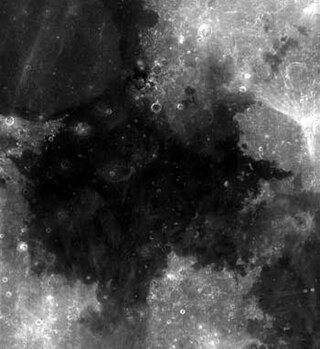
Mare Tranquillitatis is a lunar mare that sits within the Tranquillitatis basin on the Moon. It is the first location on another celestial body to be visited by humans.
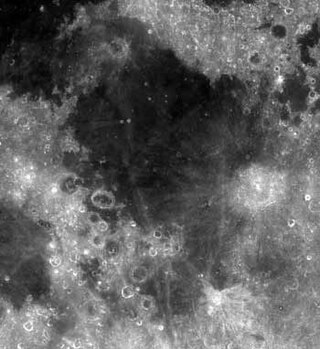
Mare Fecunditatis is a lunar mare in the eastern half of the visible Moon. The mare has a maximum diameter of 840 km.
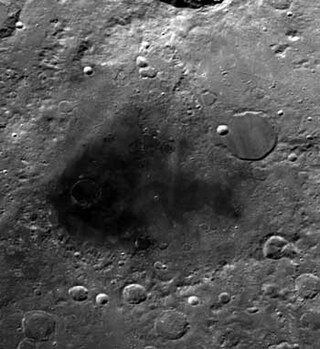
Mare Humboldtianum is a lunar mare located just to the east of Mare Frigoris, in the center of Humboldtianum basin. It is located along the northeastern limb of the Moon, and continues on to the far side. Due to its location, the visibility of this feature can be affected by libration, and on occasion it can be hidden from view from Earth.

Mare Moscoviense is a lunar mare that sits in the Moscoviense basin. It is one of the very few maria on the far side of the Moon. Like Mare Marginis, this mare appears to be fairly thin. However, it is clearly centered within a large impact basin. It is also much lower than either the outer basin floor or the farside highlands.

Mare Nectaris is a small lunar mare or sea located south of Mare Tranquillitatis southwest of Mare Fecunditatis, on the near side of the Moon. Montes Pyrenaeus borders the mare to the east and Sinus Asperitatis fuses to its northwestern edge. It is 84,000 square kilometers in size.

Mare Serenitatis is a lunar mare located to the east of Mare Imbrium on the Moon. Its diameter is 674 km (419 mi).
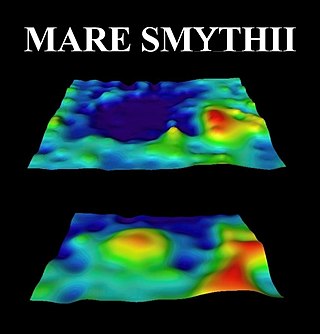
In astronomy, astrophysics and geophysics, a mass concentration is a region of a planet's or moon's crust that contains a large positive gravity anomaly. In general, the word "mascon" can be used as a noun to refer to an excess distribution of mass on or beneath the surface of an astronomical body, such as is found around Hawaii on Earth. However, this term is most often used to describe a geologic structure that has a positive gravitational anomaly associated with a feature that might otherwise have been expected to have a negative anomaly, such as the "mascon basins" on the Moon.

Lunar Prospector was the third mission selected by NASA for full development and construction as part of the Discovery Program. At a cost of $62.8 million, the 19-month mission was designed for a low polar orbit investigation of the Moon, including mapping of surface composition including Lunar hydrogen deposits, measurements of magnetic and gravity fields, and study of lunar outgassing events. The mission ended July 31, 1999, when the orbiter was deliberately crashed into a crater near the lunar south pole, after the presence of hydrogen was successfully detected.
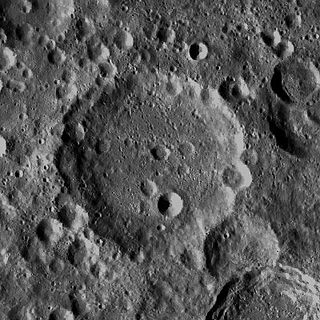
Anderson is a lunar impact crater that is located on the far side of the Moon. It is located to the northwest of the crater Sharonov, and the satellite crater Sharanov X is attached to the southeast rim of Anderson. To the northeast is the peculiar formation Buys-Ballot, and to the east-southeast lies the larger crater Spencer Jones.

Buys-Ballot is an oddly-shaped lunar impact crater that is located on the far side of the Moon. It lies just to the northwest of the small lunar mare named Lacus Luxuriae, and southeast of the crater Freundlich. Other nearby craters of note are Anderson to the southwest and Dante to the northeast.

Hertzsprung is an enormous lunar impact crater, or impact basin, that is located on the far side of the Moon, beyond the western limb. In dimension, this formation is larger than several of the lunar mare areas on the near side. It lies in the northwestern fringe of the blast radius of the Mare Orientale impact basin. Nearby craters of note include Michelson across the northeast rim, Vavilov across the western rim, and Lucretius to the southeast.
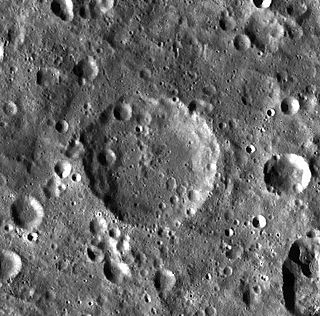
Freundlich is a lunar impact crater that is located on the far side of the Moon. It lies midway between the craters Trumpler to the north-northwest and the irregular Buys-Ballot to the south-southeast. This crater has a circular rim that is more heavily eroded at the northern and southern ends. Groups of craters lie across the floor to the southeast and the north, and individual small craters lie elsewhere within the interior. The crater is named after Erwin Freundlich.

Spencer Jones is a lunar impact crater on the Moon's far side. It is a roughly circular feature with a rim edge that is only moderately eroded. The inner wall of Spencer Jones is wider than elsewhere. The interior floor is relatively level with a low ridge offset to the south of the midpoint. Attached to the southwestern outer rim is the small satellite crater Spencer Jones Q.
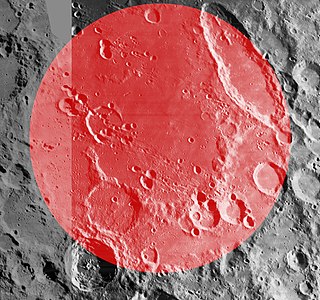
The Schiller-Zucchius Basin is a Pre-Nectarian impact basin on the near side of the Moon. It is named after the elongated crater Schiller at the northeast margin and fresh crater Zucchius near the southwest margin. This basin has received the unofficial designation 'Schiller Annular Plain' among lunar observers.

The Mendel-Ryberg Basin is a Nectarian impact basin on the southwestern limb of the moon. It is named after the crater Mendel on the west margin and the smaller crater Rydberg north of the center of the basin. The basin is due south of the larger, younger Orientale basin, and ejecta and other geomorphological effects from the younger basin have overprinted the older one.
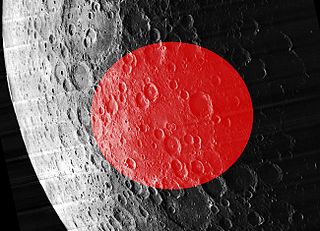
The Coulomb-Sarton Basin is a Pre-Nectarian impact basin on the far side of the Moon. It is named after the crater Coulomb northeast of the center of the basin and the smaller crater Sarton just south of the center. The basin is not obvious on the lunar surface. There are only small fragments of inner rings and a rim, and the most indicative topographic feature is a smooth, low plain at the center.























